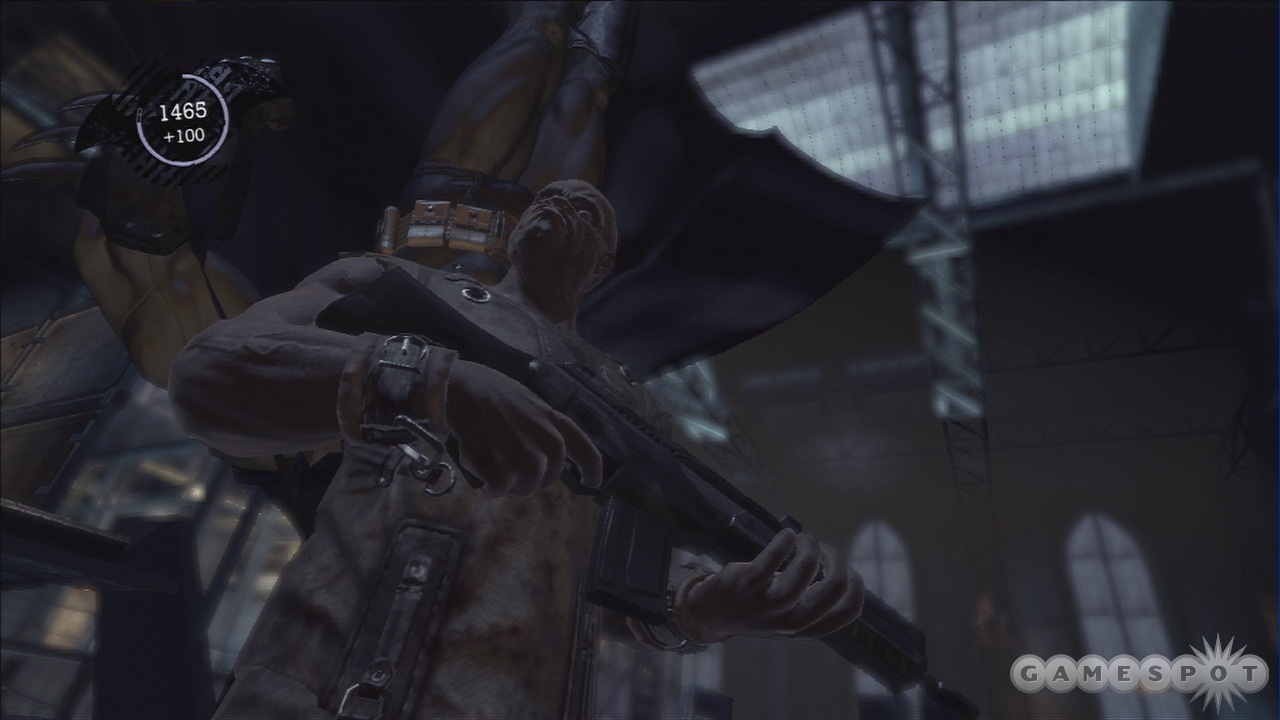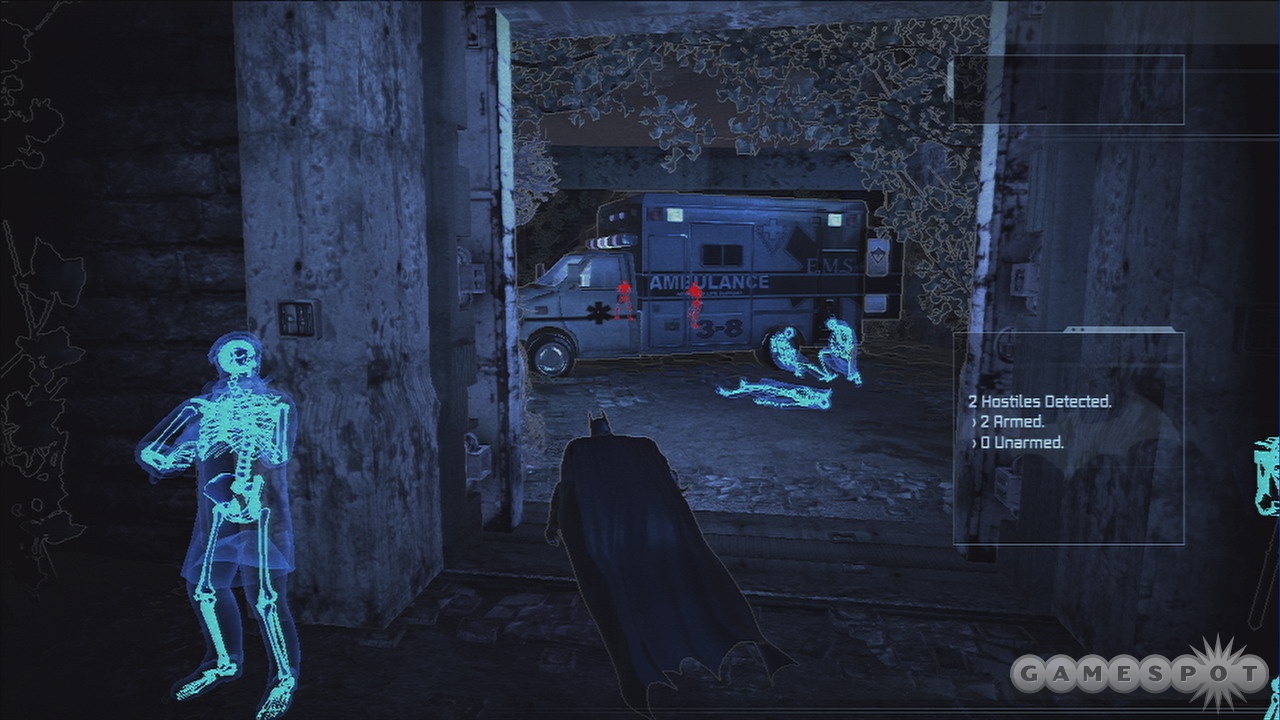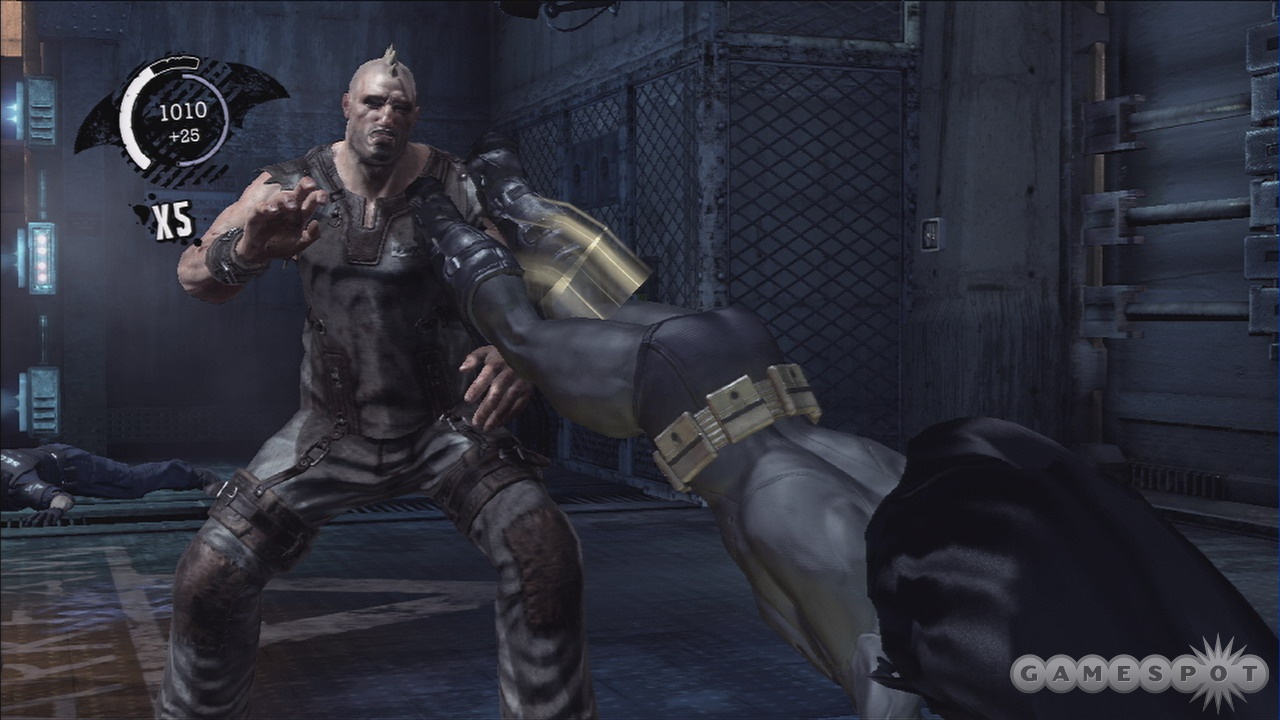You've heard of Batman no doubt, but if you don't read comics, it's conceivable that you might be unfamiliar with Arkham Asylum. The iconic psychiatric hospital is essentially Gotham City's Alcatraz, and it has housed just about every villain Batman has ever tangled with at one time or another. Now, thanks to Eidos and developer Rocksteady, Arkham is also the setting for a great third-person action game in which the lunatics take over the asylum and only you can stop them. As Batman, you not only get to go toe-to-toe with thugs in fast-paced punch-ups, but you also employ satisfying stealth tactics, play with great gadgets, solve some remarkable riddles, and do a decent amount of detective work. In short, you get to do all of the things that you want to when you don a Batman costume in a game, provided you weren't hoping to get behind the wheel of the batmobile.
Because just about everything else needs to be unlocked, the first time you boot up Batman: Arkham Asylum, your first port of call will inevitably be the Story mode. Here, you learn that Batman has captured Joker, and as the lengthy intro sequence plays out, you see him being returned to the asylum under Batman's watchful eye. Joker doesn't seem at all perturbed by his predicament, and it quickly becomes apparent that he has deliberately allowed himself to be captured as part of a grand plan that involves taking control of Arkham Island and throwing a party there with Batman as the guest of honor. Clearly it's a trap, but as Batman (and as someone who demands more than two minutes of gameplay before the credits roll), you just can't walk away from it.
As you take the controls, Arkham Asylum wastes no time throwing you into the thick of the action. Almost immediately, you're rushed by a few of Joker's goons and encouraged to knock them out using both basic attacks and counters. Using just two buttons, you can perform a huge number of moves from Batman's superbly animated repertoire, and it isn't at all difficult to string together combos worthy of Hollywood's finest fight coordinators. That's because for the most part, at least early in the game, combat requires you to do little more than mash the attack button and then hit the counter button anytime you notice an enemy with an "I'm about to attack you" icon above his head. None of the thugs that you encounter pose much of a threat individually, but you rarely encounter fewer than three or four of them at once, and often, you'll be up against six or more. Furthermore, the vanilla thugs are joined by enemies with knives, cattle prods, and guns later on, who force you to raise your game and incorporate stun attacks and evasive rolls into your deadly dance routine. Boss battles against supervillains like Scarecrow and Harley Quinn are definitely among the game's highlights, though it's a little disappointing that there aren't more of them. One supervillain in particular makes a number of appearances, but you never actually get to fight him.

The combat in Arkham Asylum never gets overly complicated, though the number of moves and attacks at your disposal increases quite dramatically as you progress through the Story mode, earn experience points, and subsequently spend those points on acquiring new combo moves and gadgets. Throws, takedowns, and even batarang attacks can be incorporated into your combos this way, but you never need to press more than two buttons simultaneously, and the timing of your moves doesn't have to be particularly precise. Fighting against mobs of up to a dozen enemies or so is a blast, and while they're not smart enough to all just jump on you at once, they're not stupid either. Given half a chance, thugs will pull pipes from walls to attack you with, pick up boxes to throw at you, and recover weapons from fallen colleagues. Fortunately, there's one weapon that your foes seem blissfully unaware of but which Batman is incredibly comfortable with: the environment.
Your surroundings don't always have a role to play in combat, but during large set piece encounters (many of which can be replayed against the clock in Challenge mode), using them to your advantage is practically a requirement. Picture this: You walk into a large room where eight gun-carrying enemies have been instructed by Joker to keep an eye out for you. You can't leave the room until every single one of them is unconscious, and going toe-to-toe with them isn't an option because--at least as far as this game is concerned--bullets are Batman's kryptonite. What do you do? Job one is to stay out of sight, which can often be accomplished by crouching atop gargoyles mounted high on the walls that, while an unusual interior design choice, make near-perfect hiding spots from which to survey the scene using your X-ray-like detective vision. From a vantage point like that, you can perform glide kicks to swoop down and floor enemies passing nearby, perform awesome "inverted takedowns" to grab guys as they pass directly beneath you and leave them hanging on ropes for their comrades to see, and throw batarangs that serve a number of useful purposes. Or, if you need to move, you can use your grapnel gun to zip to another location. Just be sure to suspend your disbelief as you do so because you're invisible to the enemy when you're in transit.

Once you've thinned your number of enemies a bit, it's safer for you to move around on the ground, and that's when you can really start to use the environment to your advantage. You can rig explosives to bring walls and ceilings down on top of enemies, crash through windows and ceilings, hide in floor grates and emerge directly behind unsuspecting enemies, and, well, you get the idea. All of these actions can be performed quickly and easily, but that doesn't make them any less satisfying when they work.
The reactions of enemies who know that their colleagues are being picked off one by one adds massively to the feeling that you're playing as a bona fide superhero. As their numbers diminish, enemies become visibly more scared--they start to move around in pairs rather than individually, press up against walls and lean around corners, and ultimately get so panicked that they fire a shot anytime they turn a corner. Listening to their superbly voiced conversations clues you into their state of mind as well. Initially, your enemies will be quite bold, loudly making threats and musing on how famous they're going to be for killing you. But as the odds gradually shift in your favor and Joker taunts them, they exude less and less confidence--ultimately sounding like they're resigned to their fates and might start crying at any moment.
The quality of the voice acting never falters for a second in Arkham Asylum, and while Mark Hamill's Joker is unsurprisingly a standout, there are great performances from other characters too. Listing them here would be to risk spoiling elements of the story for you, particularly where the other villains are concerned. You just need to know that every character in the game is well written, well voiced, and often well worth listening to--whether it's a supervillain, a thug, an ally, or a lowly security guard.

One character that you definitely want to listen to carefully is Edward Nigma, also known as Riddler. That's because there are no fewer than 240 "riddles" for you to solve on Arkham Island, and doing so not only earns you a good number of experience points but is also the only way to unlock character bios, character trophies (detailed character models that you can examine and admire at your leisure), and Challenge mode maps. The riddles come in a number of different flavors, many of which don't involve riddles at all, and the one thing that they all have in common is that they're rewarding to solve. For example, finding hidden patient interview tapes or chronicles of Arkham affords you additional insight into the asylum's history and inmates, while cracking a cryptic clue to locate an item that you need to take a photo of might make you feel smart and, if you're lucky, earn you enough experience points to purchase your next upgrade. The best of the proper riddles are those that lead you to photograph question marks painted around the island, which doesn't sound very interesting until you realize that these question marks can only be seen using detective vision from very specific locations. That's because these elusive punctuation marks are painted in two parts at different locations that are often quite far apart, so the solution requires you to find both parts and then figure out where to take the photo from so that they line up perfectly. It's clever and compelling stuff, though it does encourage you to spend more time than you'd probably like in detective vision mode.
In fact, it's likely that you'll spend a good portion of your time with Arkham Asylum in detective vision mode even if you're not looking for hidden question marks. In regular vision mode, you just get to see that this is a great-looking game with superb animation, excellent lighting, and impressive attention to detail. But when you switch to detective vision, you can immediately spot destructible surfaces, more easily locate hidden items, and spot enemies through walls. You can even tell at a glance which of those enemies have guns and which don't because they're colored differently. It's unfortunate that the predominantly blue-with-white outlines vision mode is so invaluable because, while it's an interesting look, it's akin to reading a black-and-white photocopy of a beautifully colored comic book.

If you're a fan of Batman comic books, you should feel very at home in Arkham Asylum. There are plenty of nods and winks to inmates who don't actually appear in the game, and even some of the minor characters have neat backstories that are faithful to their previous, infrequent appearances in comics. You shouldn't feel intimidated if you're not that familiar with Batman, though, because the game does a great job of giving you all of the information you need, as well as plenty that you don't. For example, taking the time to read prominent character Harley Quinn's bio and listen to her patient interviews offers valuable insight into her motivations that might add to your enjoyment of the game, while unlockable information on such characters as Prometheus, Calendar Man, and Humpty Dumpty just adds a little flavor.
More significant unlockable content comes in the form of eight challenge maps, which come in regular and extreme difficulties for a total of 16. (24 on PS3 if you include the platform-exclusive free DLC option to play some of them as Joker, whose abilities are quite different to Batman's). The maps are based on areas that you visit in the Story mode, and the challenges are split 50/50 between purely combat-oriented sequences and stealth-based "Predator" gameplay. In the former, you're pitted against four increasingly tough waves of enemies and score points for performing combos, avoiding taking damage, executing ring outs, and using a variety of different moves. In the latter, you're dropped into a level where every enemy has a gun and your goal is to take them all down as quickly as possible. The twist is that to earn a respectable position on the leaderboard in the Challenge mode, you also have to earn medals, and in order to do that, you have to deal with some of your enemies in very specific ways. During a stealth challenge, for example, earning the maximum possible three medals might require you to perform a silent takedown from behind and an inverted takedown, as well as pull an enemy down from a walkway while hanging from a ledge.

The medals get even more demanding in extreme challenges, where you need to knock guys out while crashing through windows, pull floors out from underneath multiple enemies, and even cause three different walls to fall on three different thugs simultaneously. In regular stealth challenges, the wall-mounted gargoyles are your best friends, but on extreme maps, all of the gargoyles are booby-trapped to blow up shortly after you land on them. Robbed of these safe vantage points, you have to spend a lot more time moving around on the ground, which--because you have detective vision--you can do without needing to stop and peek around every corner. Stealth gameplay is almost never this fast-paced or action-packed, and it's rarely this fun.
Regardless of whether you're getting sucked into the Story mode or competing for high scores in the Challenge mode, Batman: Arkham Asylum does an outstanding job of letting you be Batman. Everything about this game--the impressive visuals, stirring soundtrack, superb voice acting, fiendish puzzles, hard-hitting combat--feels like it has been lovingly crafted by a development team that's both knowledgeable and passionate about the source material. Miss out on this one and the joke's on you.